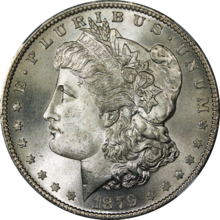
Back دولار مورغان Arabic Morgan-Dollar German Dólar Morgan Spanish دلار مورگان Persian Pièce de 1 dollar américain Morgan French Dólar Morgan Galician Dolar Morgan ID Dollaro Morgan Italian ಮಾರ್ಗನ್ ಡಾಲರ್ Kannada Morgan dollar Dutch
| Value | 1 United States dollar |
|---|---|
| Mass | 26.73 g (4121⁄2 gr) |
| Diameter | 38.1 mm (1.5 in) |
| Thickness | 2.4 mm (0.09 in) |
| Edge | Reeded |
| Composition |
|
| Years of minting | 1878–1904, 1921, 2021–present |
| Mint marks |
|
| Obverse | |
 | |
| Design | Liberty |
| Designer | George T. Morgan |
| Design date | 1878 |
| Reverse | |
 | |
| Design | Eagle clasping arrows and olive branch |
| Designer | George T. Morgan |
| Design date | 1878 |
The Morgan dollar is a United States dollar coin minted from 1878 to 1904, in 1921, and beginning again in 2021 as a collectible. It was the first standard silver dollar minted since the passage of the Coinage Act of 1873, which ended the free coining of silver and the production of the previous design, the Seated Liberty dollar. It contained 412.5 Troy grains of 90% pure silver (or 371.25 Troy grains = 24.057 g; 0.7734 ozt of pure silver). The coin is named after its designer, United States Mint Assistant Engraver George T. Morgan. The obverse depicts a profile portrait representing Liberty, modeled by Anna Willess Williams, while the reverse depicts an eagle with wings outstretched. The mint mark, if present, appears on the reverse above between D and O in "Dollar".
The dollar was authorized by the Bland–Allison Act. Following the passage of the 1873 act, mining interests lobbied to restore free silver, which would require the Mint to accept all silver presented to it and return it, struck into coin. Instead, the Bland–Allison Act was passed, which required the Treasury to purchase between two and four million dollars' worth of silver at market value to be coined into dollars each month. In 1890, the Bland–Allison Act was repealed by the Sherman Silver Purchase Act, which required the Treasury to purchase 4,500,000 troy ounces (140,000 kg) of silver each month, but only required further silver dollar production for one year. This act, once again, was repealed in 1893.
In 1898, Congress approved a bill that required all remaining bullion purchased under the Sherman Silver Purchase Act to be coined into silver dollars. When those silver reserves were depleted in 1904, the Mint ceased to strike the Morgan dollar. The Pittman Act, passed in 1918, authorized the melting and recoining of millions of silver dollars. Pursuant to the act, Morgan dollars resumed mintage for one year in 1921. The design was replaced by the Peace dollar later the same year.
In the early 1960s, a large quantity of uncirculated Morgan dollars in their original bags were discovered in the Treasury vaults, including issues once thought rare. Individuals began purchasing large quantities of the pieces at face value and then removed them from circulation through hoarding, and eventually the Treasury ceased exchanging silver certificates for silver coin. Beginning in the 1970s, the Treasury conducted a sale of silver dollars minted at the Carson City Mint through the General Services Administration. In 2006, Morgan's reverse design was used on a silver dollar issued to commemorate the old San Francisco Mint building. The US Mint began striking Morgan Dollars again in 2021, initially as a commemorative to celebrate the 100th anniversary of the conclusion of the design's final usage, then as an annual release starting in 2023.
© MMXXIII Rich X Search. We shall prevail. All rights reserved. Rich X Search